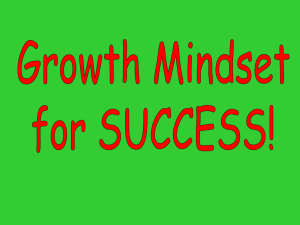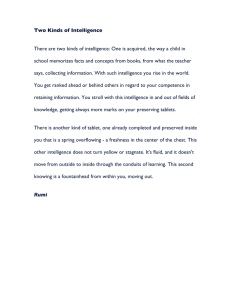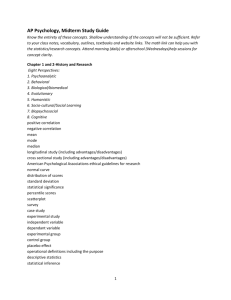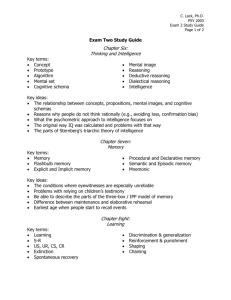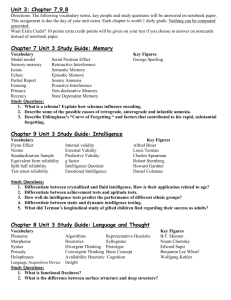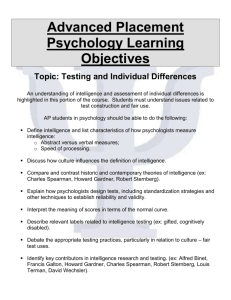Please note all vocabulary words are fair game on the midterm
advertisement
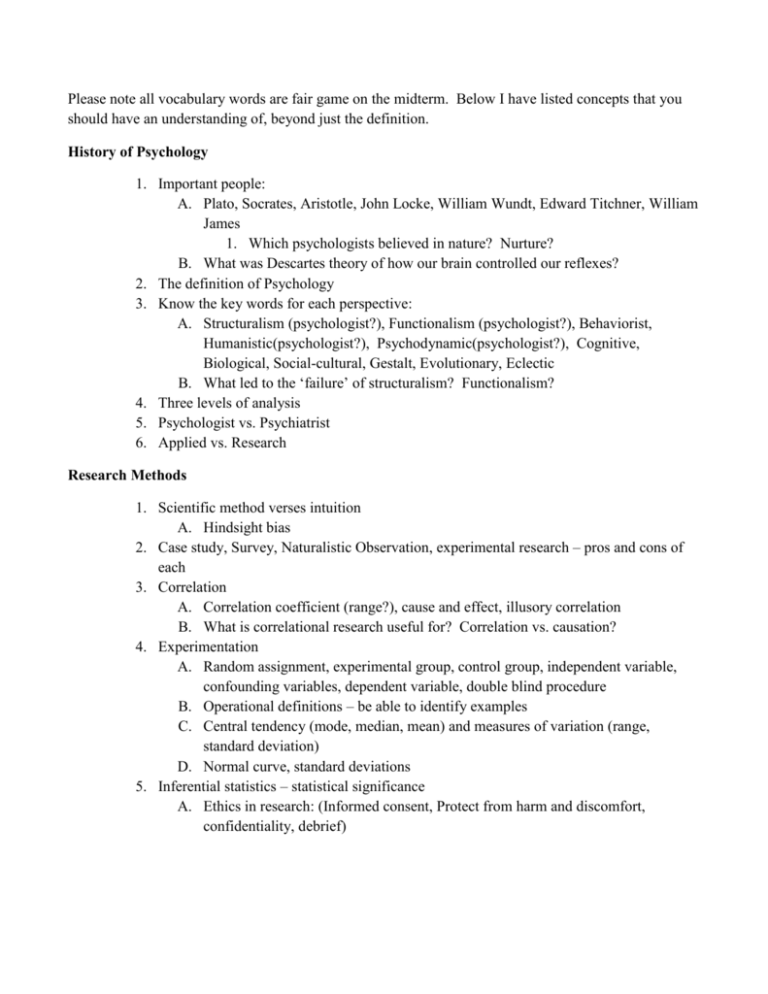
Please note all vocabulary words are fair game on the midterm. Below I have listed concepts that you should have an understanding of, beyond just the definition. History of Psychology 1. Important people: A. Plato, Socrates, Aristotle, John Locke, William Wundt, Edward Titchner, William James 1. Which psychologists believed in nature? Nurture? B. What was Descartes theory of how our brain controlled our reflexes? 2. The definition of Psychology 3. Know the key words for each perspective: A. Structuralism (psychologist?), Functionalism (psychologist?), Behaviorist, Humanistic(psychologist?), Psychodynamic(psychologist?), Cognitive, Biological, Social-cultural, Gestalt, Evolutionary, Eclectic B. What led to the ‘failure’ of structuralism? Functionalism? 4. Three levels of analysis 5. Psychologist vs. Psychiatrist 6. Applied vs. Research Research Methods 1. Scientific method verses intuition A. Hindsight bias 2. Case study, Survey, Naturalistic Observation, experimental research – pros and cons of each 3. Correlation A. Correlation coefficient (range?), cause and effect, illusory correlation B. What is correlational research useful for? Correlation vs. causation? 4. Experimentation A. Random assignment, experimental group, control group, independent variable, confounding variables, dependent variable, double blind procedure B. Operational definitions – be able to identify examples C. Central tendency (mode, median, mean) and measures of variation (range, standard deviation) D. Normal curve, standard deviations 5. Inferential statistics – statistical significance A. Ethics in research: (Informed consent, Protect from harm and discomfort, confidentiality, debrief) Social Psychology 1. Explaining others behavior: attribution theory (fundamental attribution error) 2. Attitudes and actions: foot-in-the-door phenomenon, 3. Zimbardo’s Stanford prison study: role 4. Cognitive dissonance 5. Conformity and obedience: chameleon effect, Solomon Asch study, reasons for conforming, Milgram’s study (what did researchers predict would be the outcome of the Milgram experiment? What was the outcome?) 6. How does the presence of observers affect a person’s performance? 1. Social facilitation, social loafing, deindividuation, group think, group polarization, cultural norms 7. Psychological factors of aggression and love/attraction 8. Psychological factors of helping others: altruism, bystander effect 9. Social conflicts, social traps, mirror-image perceptions, and self-fulfilling prophecies. 10. What is the difference between prejudice and discrimination? 1. What is the scapegoat theory? 11. What is the just-world phenomenon Biological Bases of Behavior 1. Parts of a neuron – function of each part and the process of sending a message through a neuron i. Differences between: Sensory, motor, and inter neurons ii. Action process 2. Neurotransmitters and their functions: Acetylcholine, Dopamine, Serotonin, Norepinephrine, GABA, Glutamate i. Consequences of an undersupply of serotonin? 3. Peripheral nervous system vs. central nervous system i. Somatic nervous system, sympathetic, parasympathetic 4. Endocrine System (how are endocrine messages different than neural messages) 5. How can we study the brain: Think PET, EEG, and MRI scans (what can each tell us about the brain) 6. Functions of each part of the brain 7. Brain’s Plasticity 8. Effects of split brain 9. Right vs. left brain 10. Dual processing 11. What is a behavior geneticist and what do they study? 12. Identical twins importance in genetics – flaws? 13. What is heritability? 14. Evolutionary Psychology/Natural selection importance in genetics Sensation & Perception 1. 2. 3. 4. Difference between sensation and perception What is absolute threshold? Subliminal messages? Do they work? Vision: a. What does intensity determine in regard to color? What does wavelength determine? b. Know the correct order of light passing through the eye. c. What are rods and cones? 5. Hearing: a. Know the correct order of sound waves traveling to the auditory nerve. b. Frequency theory versus place theory? 6. Other senses a. Touch – what can influence pain? What is phantom limb syndrome? b. Taste - What is sensory interaction? c. Smell - How do we experience smell? Who has the best sense of smell? 7. Perception a. Gestalt Psychologists b. What are the different binocular cues? c. Lightness constancy? States of Consciousness 1. What is consciousness 2. Sleep: Know the different stages of sleep – what happens in each (including brain waves) 1. Consequences of sleep deprivation? 3. Hypnosis: who is most likely to be hypnotized? 4. Drugs: Tolerance, Withdrawal, Psychoactive drugs, Dependence, Addiction, Different categories of drugs – effects 1. What will happen if your brain is repeatedly exposed to artificial opiates? 2. What is the best predictor of an adolescent’s drug use? Learning 1. Associative Learning 2. Classical Conditioning (components: N, US, UR, CS, CR) a. Pavlov’s experiment b. Higher-order conditioning c. Extinction, Spontaneous Recovery, Generalization, Discrimination d. Watson and Rayners Emotional conditioning experiment 3. 4. 5. 1. 2. 3. 4. 5. e. Garcia and taste aversion f. Biological predispositions of CC Operant Conditioning a. Skinner’s box b. Law of effect c. Shaping d. Discriminative stimulus e. Reinforcements i. Positive ii. Negative iii. Immediate vs. delayed – which is better? iv. Continuous v. Partial reinforcement schedule: variable ratio, fixed ratio, variable interval, fixed interval vi. Primary and conditioned reinforce vii. Problems with reinforcements f. Punishments i. Positive vs negative ii. Problems with punishment g. Biological predispositions in operant conditioning Observational Learning Modeling Bandura’s experiment Mirror neurons Prosocial Desensitization Cognitive Learning Cognitive maps Latent learning Insight learning Intrinsic Motivation & Extrinsic Motivation Biofeedback Learned helplessness Biological predispositions to learning Biopsychosocial approach to learning Psychologists associated with each type of learning Cognition: Memory 7A 1. Define: Memory 2. Explain steps of information processing: Encoding, storage, and retrieval 3. Explain the stages to the connectionism model of learning: a. Sensory memory (duration): Iconic memory, echoic memory b. Short term memory (duration, capacity) c. Long-term memory 4. What is the Modified three-stage processing model of memory: a. Working memory b. Parallel processing c. Automatic processing 5. Components of effortful processing: Rehearsal, The spacing effect, testing effect, Serial position effect (recency and primacy effect) 6. Levels of processing: Semantic encoding, acoustic encoding, and visual encoding 7. Define: Rosy retrospection, Mnemonic device - Peg word system, State dependent memory, Chunking 8. The brain and memories: Memory trace, Long-term Potentiation, CREB 9. Stress hormones and memory, Flashbulb memories 10. Implicit and explicit memories – where are they stored? a. Amnesia b. Hippocampus and memory c. Cerebellum and memory 11. What is infantile amnesia? 12. Define: Recall and recognition memory 13. Retrieval cues: Priming, Déjà vu, Context memory, Mood-congruent 14. Forgetting: Proactive interference and retroactive interference, Repression, Misinformation effect, Source amnesia Cognition: Thinking 7B 1. Define: Cognition, concepts, prototypes, intuition, framing 2. Problem solving strategies: algorithms, heuristics, insight 3. Creativity: components of creativity 4. Obstacles to problem solving: confirmation bias, fixation, mental set, functional fixedness, representative heuristic, availability heuristic, overconfidence, belief perseverance 5. Language a. Phoneme, morpheme, b. Semantics c. Syntax d. Receptive language e. Productive language f. Stages of speech development g. Telegraphic speech h. Chomsky’s theory of language development i. Generalization in children’s speech j. Critical period of development k. Whorf: linguistic determinism Testing and Individual differences Chapter: I. II. How do we define intelligence? What is savant syndrome? III. IV. V. VI. VII. VIII. IX. What is an intelligence test? IQ Different theories of intelligence: A. Spearman: g factor B. Thurston’s theory C. Gardner’s eight intelligences D. Sternberg’s three intelligence E. emotional intelligence The brain and intelligence A. Does size matter? Where? B. Brain complexity studies: neural plasticity, gray matter versus white matter C. Brain function: perceptual speed and neurological speed Assessing Intelligence A. History of intelligence testing i. Francis Galton’s intelligence testing: reaction time, sensory acuity, muscular power, body proportions ii. Alfred Binet: mental age, chronological age, Lewis Terman, intelligence quotient equation, average IQ B. aptitude test and achievement test – know the difference between the two and be able to identify examples C. Wechsler Adult Intelligence scale, WISC Evaluating intelligence tests: standardization, normal curve, Flynn effect A. Reliability: scores correlate, test-retest reliability, split-half reliability B. Validity: content validity (criterion), predictive validity Dynamics of intelligence A. Are intelligence scores stable over life span? B. Low extreme: intellectual disability i. Mental retardation, down syndrome (21st chromosome), mainstreamed ii. Classifications of intellectual disability: levels and adaptation to demands of life C. High Extreme i. Terman’s study of gifted, self-fulfilling prophecy, appropriate developmental placement (tracking students) Genetic and environmental influences on intelligence A. Twin and adoption studies: polygenetic, adoptive children studies B. Heritability C. Environmental influences: tutored human enrichment, targeted training, schooling and intelligence (project head start) D. Gender similarities and differences: spelling, verbal ability, nonverbal ability, sensation, emotion-detecting ability, math and spatial aptitudes E. Ethnic similarities and ethnic differences F. The question of bias: two meaning of bias (popular sense/scientific sense), test-taker’s expectations (stereotype threat)
